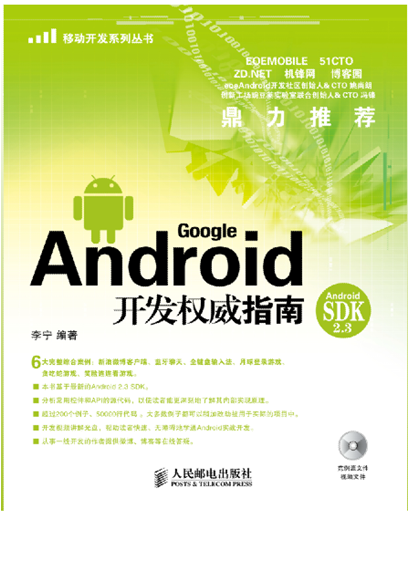《Android/OPhone開發完全講義》連載(7):使用SharedPreferences存取復雜數據
本文為《Android/OPhone開發完全講義》一書的內容連載。轉載請注明出處
我們知道SharedPreferences只能保存簡單類型的數據,例如,String、int等。如果想用SharedPreferences存取更 復雜的數據類型(類、圖像等),就需要對這些數據進行編碼。我們通常會將復雜類型的數據轉換成Base64編碼,然后將轉換后的數據以字符串的形式保存在 XML文件中。
Android SDK中并未提供Base64編碼和解碼庫。因此,需要使用第三方的jar包。在本例中使用了Apache Commons組件集中的Codec組件進行Base64編碼和解碼。讀者可以從如下的地址下載Codec組件的安裝包。
http://commons.apache.org/codec/download_codec.cgi
在Android工程目錄的lib子目錄中已經包含了Codec組件的jar包(commons-codec-1.4.jar),因此,讀者可以在該工程中直接使用Codec組件。
在本例中將一個Product類的對象實例和一個圖像保存在XML文件中,并在程序重新運行后從XML文件裝載Product對象和圖像。下面是Product類的代碼:
在存取數據之前,需要使用下面的代碼創建一個SharedPreferences對象。
mySharedPreferences = getSharedPreferences("base64",Activity.MODE_PRIVATE);
其中mySharedPreferences是在類中定義的SharedPreferences類型變量。
在保存Product對象之前,需要創建Product對象,并將相應組件中的值賦給Product類的相應屬性。將Product對象保存在XML文件中的代碼如下:
保存圖像的方法與保存Product對象的方法類似。由于在保存之前,需要選擇一個圖像,并將該圖像顯示在ImageView組件中,因此,從ImageView組件中可以直接獲得要保存的圖像。將圖象保存在XML文件中的代碼如下:
其中compress方法的第2個參數表示壓縮質量,取值范圍是0至100,0表示最高壓縮比,但圖像效果最差,100則恰恰相反。在本例中取了一個中間值50。
從XML文件中裝載Product對象和圖像是保存的逆過程。也就是從XML文件中讀取Base64格式的字符串,然后將其解碼成字節數組,最后將字節數組轉換成Product和Drawable對象。裝載Product對象的代碼如下:
裝載圖像的代碼如下:
在上面的代碼中使用了Drawable類的createFromStream方法直接從流創建了Drawable對象,并使用setImageDrawable方法將圖像顯示在ImageView組件上。
在 這里需要提一下的是圖像選擇。在本例中使用了res\drawable目錄中的除了icon.png外的其他圖像。為了能列出這些圖像,本例使用了 Java的反射技術來枚舉這些圖像的資源ID。基本原理是枚舉R.drawable類中所有的Field,并獲得這些Field的值。如果采用這個方法, 再向drawable目錄中添加新的圖像,或刪除以前的圖像,并不需要修改代碼,程序就可以顯示最新的圖像列表。枚舉圖像資源ID的代碼如下:
運行本例后,單擊【選擇產品圖像】按鈕,會顯示一個圖像選擇對話框,如圖1所示。選中一個圖像后,關閉圖像選擇對話框,并單擊【保存】按鈕。如果保存成功,將顯示如圖2所示的提示對話框。當再次運行程序后,會顯示上次成功保存的數據。


查看base64.xml文件,會看到如下的內容:
注意:雖然可以采用編碼的方式通過SharedPreferences保存任何類型的數據,但作者并不建議使用SharedPreferences保存尺寸很大的數據。如果讀者要存取更
新浪微博:http://t.sina.com.cn/androidguy 昵稱:李寧_Lining
我們知道SharedPreferences只能保存簡單類型的數據,例如,String、int等。如果想用SharedPreferences存取更 復雜的數據類型(類、圖像等),就需要對這些數據進行編碼。我們通常會將復雜類型的數據轉換成Base64編碼,然后將轉換后的數據以字符串的形式保存在 XML文件中。
Android SDK中并未提供Base64編碼和解碼庫。因此,需要使用第三方的jar包。在本例中使用了Apache Commons組件集中的Codec組件進行Base64編碼和解碼。讀者可以從如下的地址下載Codec組件的安裝包。
http://commons.apache.org/codec/download_codec.cgi
在Android工程目錄的lib子目錄中已經包含了Codec組件的jar包(commons-codec-1.4.jar),因此,讀者可以在該工程中直接使用Codec組件。
在本例中將一個Product類的對象實例和一個圖像保存在XML文件中,并在程序重新運行后從XML文件裝載Product對象和圖像。下面是Product類的代碼:
package net.blogjava.mobile;
import java.io.Serializable;
// 需要序列化的類必須實現Serializable接口
public class Product implements Serializable
{
private String id;
private String name;
private float price;
// 此處省略了屬性的getter和setter方法


import java.io.Serializable;
// 需要序列化的類必須實現Serializable接口
public class Product implements Serializable
{
private String id;
private String name;
private float price;
// 此處省略了屬性的getter和setter方法


在存取數據之前,需要使用下面的代碼創建一個SharedPreferences對象。
mySharedPreferences = getSharedPreferences("base64",Activity.MODE_PRIVATE);
其中mySharedPreferences是在類中定義的SharedPreferences類型變量。
在保存Product對象之前,需要創建Product對象,并將相應組件中的值賦給Product類的相應屬性。將Product對象保存在XML文件中的代碼如下:
Product product = new Product();
product.setId(etProductID.getText().toString());
product.setName(etProductName.getText().toString());
product.setPrice(Float.parseFloat(etProductPrice.getText().toString()));
ByteArrayOutputStream baos = new ByteArrayOutputStream();
ObjectOutputStream oos = new ObjectOutputStream(baos);
// 將Product對象放到OutputStream中
oos.writeObject(product);
mySharedPreferences = getSharedPreferences("base64", Activity.MODE_PRIVATE);
// 將Product對象轉換成byte數組,并將其進行base64編碼
String productBase64 = new String(Base64.encodeBase64(baos.toByteArray()));
SharedPreferences.Editor editor = mySharedPreferences.edit();
// 將編碼后的字符串寫到base64.xml文件中
editor.putString("product", productBase64);
editor.commit();
product.setId(etProductID.getText().toString());
product.setName(etProductName.getText().toString());
product.setPrice(Float.parseFloat(etProductPrice.getText().toString()));
ByteArrayOutputStream baos = new ByteArrayOutputStream();
ObjectOutputStream oos = new ObjectOutputStream(baos);
// 將Product對象放到OutputStream中
oos.writeObject(product);
mySharedPreferences = getSharedPreferences("base64", Activity.MODE_PRIVATE);
// 將Product對象轉換成byte數組,并將其進行base64編碼
String productBase64 = new String(Base64.encodeBase64(baos.toByteArray()));
SharedPreferences.Editor editor = mySharedPreferences.edit();
// 將編碼后的字符串寫到base64.xml文件中
editor.putString("product", productBase64);
editor.commit();
保存圖像的方法與保存Product對象的方法類似。由于在保存之前,需要選擇一個圖像,并將該圖像顯示在ImageView組件中,因此,從ImageView組件中可以直接獲得要保存的圖像。將圖象保存在XML文件中的代碼如下:
ByteArrayOutputStream baos = new ByteArrayOutputStream();
// 將ImageView組件中的圖像壓縮成JPEG格式,并將壓縮結果保存在ByteArrayOutputStream對象中
((BitmapDrawable) imageView.getDrawable()).getBitmap().compress(CompressFormat.JPEG, 50, baos);
String imageBase64 = new String(Base64.encodeBase64(baos.toByteArray()));
// 保存由圖像字節流轉換成的Base64格式字符串
editor.putString("productImage", imageBase64);
editor.commit();
// 將ImageView組件中的圖像壓縮成JPEG格式,并將壓縮結果保存在ByteArrayOutputStream對象中
((BitmapDrawable) imageView.getDrawable()).getBitmap().compress(CompressFormat.JPEG, 50, baos);
String imageBase64 = new String(Base64.encodeBase64(baos.toByteArray()));
// 保存由圖像字節流轉換成的Base64格式字符串
editor.putString("productImage", imageBase64);
editor.commit();
其中compress方法的第2個參數表示壓縮質量,取值范圍是0至100,0表示最高壓縮比,但圖像效果最差,100則恰恰相反。在本例中取了一個中間值50。
從XML文件中裝載Product對象和圖像是保存的逆過程。也就是從XML文件中讀取Base64格式的字符串,然后將其解碼成字節數組,最后將字節數組轉換成Product和Drawable對象。裝載Product對象的代碼如下:
String productBase64 = mySharedPreferences.getString("product", "");
// 對Base64格式的字符串進行解碼
byte[] base64Bytes = Base64.decodeBase64(productBase64.getBytes());
ByteArrayInputStream bais = new ByteArrayInputStream(base64Bytes);
ObjectInputStream ois = new ObjectInputStream(bais);
// 從ObjectInputStream中讀取Product對象
Product product = (Product) ois.readObject();
// 對Base64格式的字符串進行解碼
byte[] base64Bytes = Base64.decodeBase64(productBase64.getBytes());
ByteArrayInputStream bais = new ByteArrayInputStream(base64Bytes);
ObjectInputStream ois = new ObjectInputStream(bais);
// 從ObjectInputStream中讀取Product對象
Product product = (Product) ois.readObject();
裝載圖像的代碼如下:
String imageBase64 = mySharedPreferences.getString("productImage","");
base64Bytes = Base64.decodeBase64(imageBase64.getBytes());
bais = new ByteArrayInputStream(base64Bytes);
// 在ImageView組件上顯示圖像
imageView.setImageDrawable(Drawable.createFromStream(bais,"product_image"));
base64Bytes = Base64.decodeBase64(imageBase64.getBytes());
bais = new ByteArrayInputStream(base64Bytes);
// 在ImageView組件上顯示圖像
imageView.setImageDrawable(Drawable.createFromStream(bais,"product_image"));
在上面的代碼中使用了Drawable類的createFromStream方法直接從流創建了Drawable對象,并使用setImageDrawable方法將圖像顯示在ImageView組件上。
在 這里需要提一下的是圖像選擇。在本例中使用了res\drawable目錄中的除了icon.png外的其他圖像。為了能列出這些圖像,本例使用了 Java的反射技術來枚舉這些圖像的資源ID。基本原理是枚舉R.drawable類中所有的Field,并獲得這些Field的值。如果采用這個方法, 再向drawable目錄中添加新的圖像,或刪除以前的圖像,并不需要修改代碼,程序就可以顯示最新的圖像列表。枚舉圖像資源ID的代碼如下:
// 獲得R.drawable類中所有的Field
Field[] fields = R.drawable.class.getDeclaredFields();
for (Field field : fields)
{
if (!"icon".equals(field.getName()))
imageResIdList.add(field.getInt(R.drawable.class));
}
Field[] fields = R.drawable.class.getDeclaredFields();
for (Field field : fields)
{
if (!"icon".equals(field.getName()))
imageResIdList.add(field.getInt(R.drawable.class));
}
運行本例后,單擊【選擇產品圖像】按鈕,會顯示一個圖像選擇對話框,如圖1所示。選中一個圖像后,關閉圖像選擇對話框,并單擊【保存】按鈕。如果保存成功,將顯示如圖2所示的提示對話框。當再次運行程序后,會顯示上次成功保存的數據。
查看base64.xml文件,會看到如下的內容:
<?xml version='1.0' encoding='utf-8' standalone='yes' ?>
<map>
<string name="productImage">/9j/4AAQSkZJRgABAQAAAQABAAD/2wBDABDsyj7yK3
 </string>
</string>
<string name="product">rO0ABXNyABtuZXQuYmxvZ2phdmEubW9iaWxlLlByb2
 </string>
</string>
</map>
<map>
<string name="productImage">/9j/4AAQSkZJRgABAQAAAQABAAD/2wBDABDsyj7yK3

 </string>
</string><string name="product">rO0ABXNyABtuZXQuYmxvZ2phdmEubW9iaWxlLlByb2

 </string>
</string></map>
注意:雖然可以采用編碼的方式通過SharedPreferences保存任何類型的數據,但作者并不建議使用SharedPreferences保存尺寸很大的數據。如果讀者要存取更
《Android高薪之路:Android程序員面試寶典 》http://book.360buy.com/10970314.html
新浪微博:http://t.sina.com.cn/androidguy 昵稱:李寧_Lining
posted on 2010-09-08 09:49 銀河使者 閱讀(4068) 評論(5) 編輯 收藏 所屬分類: java 、 原創 、移動(mobile) 、 圖書 、Android/OPhone








